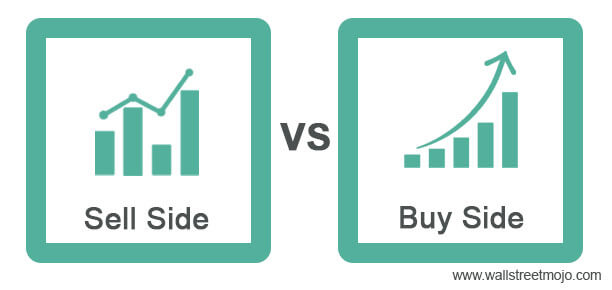Table Of Contents
Difference Between Sell Side and Buy Side
The sell-side is firms that tend to sell, issue, or trade-in financial securities, including corporations, advisory firms, and investment banks. The buy-side can be defined as firms typically buying financial securities, including pension funds, investment managers, and hedge funds.
Knowing the difference between the sell-side and buy-side is essential in the Investment Banking industry. Yet the irony is that many of us are unaware of these important terms. Many a time, I have seen that students are not only confused between these two terms but also about their usage in the context of investment banking roles in the industry. For example, statistics say that the sell-side makes up one-half of the finance market, and the buy-side makes up the other half.
- The sell-side includes the entities which facilitate the decision-making of the buy-side.
- The buy-side consists of entities that are involved in making investment decisions.
Table of contents

Firms Involved
- Sell-side includes firms like investment banking, commercial banking, stockbrokers, Market Makers, and other corporates.
- Buy-side includes asset managers, Hedge Funds, institutional investors, and retail investors.
- Buy-side firms can be bigger in operations, but the number of analysts may be lesser. These analysts often interact with the sell-side analysts.
- On the other hand, the number of analysts in the sell-side firms is higher as these analysts are dedicated to the analysis of specific sectors or specific companies.
Sell Side vs Buy Side in Video Explanation
What do they do?
- Sell-side companies closely keep track of the stocks and various companies' performance and project their future financials based on multiple analyses and trends. Then, they come up with their research recommendations (target price) in their equity research reports.
- Sell-side companies (equity research) essentially "sell ideas" to the clients, and these ideas are communicated for free in most cases.
- Their work revolves around financials and annual reports, including a detailed analysis of the quarterly results, balance sheet, or published data.
- The buy-side includes the entities that are involved in deploying their capital. They may refer to the analysis or price given by the investment banks for making their investment decisions.
- Buy-side essentially has a pool of funds that is used for investing.
- So, we can say that sell-side entities provide services to the buy-side entities to make investment decisions.
Sell-Side vs. Buy-Side Infographics

Goals
- The goal of a sell-side is to advise on research and close the deal.
- Sell-side analysts carry out research based on the same. They convince their investors to trade through their firm's
- The goal of a sell-side is to advise on research and close the deal.
- Sell-side analysts carry out research based on the same. They convince their investors to trade through their firm's trading desk.
- The buy-side firms aim to beat the indices and generate investment returns for their clients.
Sell-Side Analyst
- The sell-side analysts provide greater insights into trends, analysis, and financial projections.
- They develop recommendations and research reports to make investment decisions for their clients.
- One major difference is that sell-side analysts do their research and analysis and create their reports. These reports are available in the public domain.
- The job of an analyst is to recommend a buy or a sell recommendation for a particular security.
Skills Requirements
- Excellent analytical and quantitative skills
- Strong writing and communication skills
- Expertise in Microsoft Office suite- Excel, PowerPoint, and Word
- Ability to quickly evaluate and analyze financial information and companies
- Ability to prioritize task
- Ability to work on multiple engagements
- Commitment to obtaining outstanding results
- Ability to work for long hours
Buy Side Analyst
- You will find a very interesting difference here: the buy-side analysts' reports are not publicly available.
- These analysts use the reports created by many sell-side analysts and further carry out their analysis to make an investment decision.
- The buy-side analyst's job is not just to give a buy or sell decision but to make an investment decision adhering to the company strategy.
Skills Requirement
- Strong and intellectual eye for investment opportunities
- Monitoring the market developments
- Ability to create productive, timely, and high-quality reports for investment decisions
- Ability to analyze risks and industry characteristics
- Ability to constantly monitor portfolio performance
- Updated with the economy and global markets
- Expertise in Microsoft Office suite- Excel, Word, and PowerPoint.
Compensation
A requirement of higher skill-sets and knowledge for buy-side analysts for the investment decisions makes them fetch higher pay than the sell-side analysts. But there may always be exceptions.
Recommended Articles
This article is a guide to Sell Side vs Buy Side investment banking. We discuss the top differences between buy side and sell side. You may also have a look at the following articles: -
